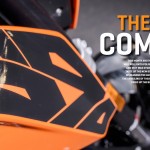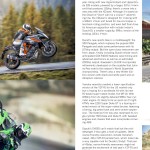Seventeen issues ago we hopped and wobbled around Saalbach summer slopes in Austria to try and offer some appraisal of KTM’s ambitious Freeride electric concept off-roader; almost the perfect antidote to the emission problem associated with taking bikes into greenery. Almost a year on and with KTM tweaking the plug-in technology for the road we’re turning heads again in Barcelona town centre. All the same feelings are there: a slim, light, nimble ride conveying almost a sense of bicycling, impressive power delivery from the 16km/22hp (running at 11kw/15hp mostly) that gets you away from any car at the lights, riding-for-dummies and the knowledge that worries over battery life can be cured by seeking out the nearest socket.
Aside from the utter ease of motoring around on the Freeride (I doubt a rider of any ability will ever find the limits and possibilities of a motorcycle quicker than with this model) that sensation I love most about the E-SM is that ‘on-tap’ feeling with the slightest turn of the throttle: instant torque and gratification and on streets where you would not want to be hitting silly speeds or gathering unnecessary attention.
KTM have a coy approach to their first electric street model. Homologation means that it will only hit certain markets and the price (topping 11,000 euros) will push it out of the realistic bounds of many, particularly as it will not function particularly well as a commuter (no storage and mileage limits) and will need more care than a majority of the crud-ridden scooters seen around the Catalan capital. For Supermoto fans it is the ultimate novelty. It could also appeal to first time riders in warmer climes that want a simple, traffic-busting solution. It could even be the exotic point of a new urban craze of stunt riding. In other words there is no clear or traditional market target for the E-SM, even if it is arguably the coolest looking battery-with-wheels. The off-road sister has obvious benefits but the street incarnation needs a relaxed play. “It was quite clear that we’d use the existing Freeride-E technology for street riding even though we knew the range of the hardware would be a limiting factor,” admits Kuttruf. “It is still a great offering for a supermoto, sprint, urban bike with a lot of potential. We don’t have clear indications when it comes to figures or a market but our evaluation right now is that roughly two-thirds of the overall Freeride E production would be dedicated to off-road and one third to Street, some 1500 motorcycles.”
How did you go about converting the E-XC and E-SX for road use and with what goal?
We feel the Freeride E-SM can be versatile. The spec system is almost identical to the E-XC but for a few adaptations for road usage. So the customer could adapt it back and forth with two sets of wheels. It can be taken into an off-road park or used on a daily basis thanks to the road homologation. The Pirellis are the biggest difference and then other small things like the shorter front fender and a slightly longer transmission. The E-XC has a top speed of around 75kmph and the SM goes easily at 90. Apart from that the spec is the same. Pollution and noise is a wide-ranging topic and not only something that affects off-road. I think it is a strong ‘plus’ and argument for these bikes, especially when it comes to the city environment. This is not the biggest advantage though: the SM is very practical and so easy to ride. It remains a ‘sport bike’ and can squeeze through and around situations. It is small, light, super-agile and goes against this perception people have of ‘E vehicles’ being heavy and ill-handling. It has a sporty character and people are not used to associating that with electric products. It is a big selling factor for the bike.
Read the rest of the story HERE








